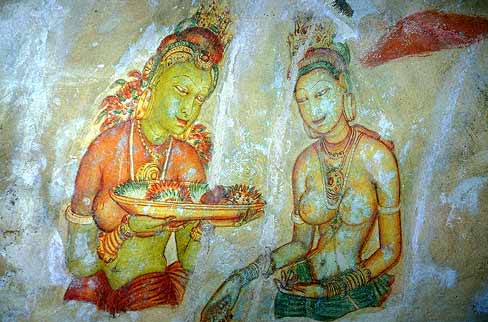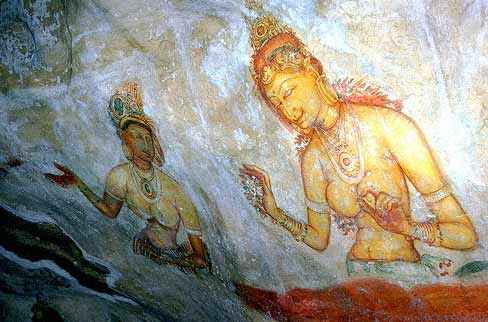Sigiriya: Who are these maidens and what is their message?

|
| Tara is a goddess who was worshipped by Mahayana Buddhists in Sri Lanka. The divine females at Sigiriya are splendidly adorned with jewellary, bracelets, necklaces, tiaras, diadems, chaplets of flowers and are of three complexions red, yellow and green. The goddess Tara too has numerous manifestations in regal splendor and may be of red, yellow, green, blue or white complexion. |

|
Kishanie S. Fernando
The Sigiriya maidens have caused much debate, discussion
and disagreement. Who are these ladies? What is their message?
These are questions that have eluded answers to generations of scholars
and art lovers.
H.E.P. Bell believed that the paintings were of the ladies of Kasyapa's court in a devotional procession to the shrine at Pidurangala. Professor Senarat Paranavitana suggested that they represented Lightning Princesses (vijju kumari) and cloud damsels (meghalata) Dr. Ananda Coomaraswamy identified them with apsaras in keeping with well established South Asian traditions. Professor Senaka Bandaranayake agrees with Coomaraswamy but adds that the celestial nymphs may have had more than one meaning and functioned as expressions of royal grandeur and status and as artistic evocations of courtly life.
In this light of debate it is interesting to consider a theory put forward by Dr. Raja De Silva Commissioner of Archeology of Sri Lanka from 1967-1979.
He supports that the paintings are representations of goddess Tara.
He bases his theory on the premise that Sigiriya was a Buddhist
site for more than a thousand years, a site he says which had a
leaning towards the Mahayana on account of the Dhammaruci viharas
there. And the greatest and most adored goddess in Mahayana Buddhism
is Tara
Dr. De Silva says that in 1967 German Swami Gauribala informed him
that the paintings were representative of Tara, and Sigiriya. was
a Mahayanist Buddhist initiation centre for aspiring bodhisattvas.
This theory was later published in Roloff Ben's book Ceylon
(1970).
Dr. De Silva says that Tara was a goddess worshipped by Mahayana Buddhists
at various monasteries in the country. The divine females are shown
splendidly adorned with jewellary, bracelets, necklaces, tiaras,
diadems, chaplets of flowers and are of three complexions red, yellow
and green. The goddess Tara has numerous manifestations in regal
splendor and is of red, yellow, green, blue and white complexions.
He supports his theory with the description of goddess Tara found in
Sudhanamala an Indian Mahayana compilation of prescriptions for
the worship of Tara and other deities which throws light on Buddhist
iconography .
He also points out that the depiction of Tara holding a water lily
or a lotus in her hand posture or vitarka mudra is common among
the paintings of Sigiriya.
Dr. De Silva is also of opinion that the lion symbolism found in Sigiriya
is connected with Tara rather than being a mere ornamental, for
Tara is likened to a great roaring lion proclaiming the Truth to
all. He says images of Tara in association with the roaring lion
have been found in India.
Dr. De Silva also reminds us that in addition to the paintings of Tara
there have been found in Sigiriya a life size limestone statues
and also terracotta models of female figures all of which may easily
be taken as images of Tara.
As such Dr. De Silva concludes that the paintings, almost without exception
portray beautiful females. The form, more or less life-size, the
blending of mellow colours, the grace of movement captured in an
instant but to be held for millennia, lend a feeling of peace and
happiness to the mind of the viewer. And the pleasure is enhanced
by the suggestion of their being goddesses in the heavens identifiable
as Tara. All this create in the mind of the beholder the disinterested
or detached judgment that enables the contemplation of beauty to
result in the pleasure mentioned above.
This
then according to Dr. De Silva, is the meaning of the Sigiriya paintings,
and the intention of the artist was to make the viewer piously believe
in the true beauty of the divine Tara, the Saviouress.
The painting of innumerable Taras on the western face of the Remembrance Rock or Sihigiri (as Sigiriya was earlier known by some and which theory is also supported by Dr. De Silva) which the devotees continuously see during the ascent to the summit, is said to have motivated to assist in religious contemplation. And to lovingly adore her and identify themselves with their Saviouress. For they believed that goddess Tara would alleviate their suffering in this world and show them the way to enlightenment.
‘Their
bodies' radiance
Like the moon
wanders in the cool wind.'
‘The
song of Lord Kital:
Sweet girl
Standing on the Mountain
Your teeth are like jewels
Lighting the lotus of your eyes
Talk to me gently of your heart.'
‘I
am Lord Sangapala
I wrote this song
We spoke
But they did not answer
Those ladies of the Mountain
They did not give us
The twitch of an eye-lid.'
‘Ladies
like you
Make men pour out their hearts
And you also have thrilled the body
Making its hair
Stiffen with desire.'
An offering of flowers in Buddhism symbolizes generosity and opening of the heart. Avas Flowers offers beautiful cut flowers and arrangements which can be used for offerings. The lotus flower, synonymous with purity in Buddhist traditions, can also be found at the Avas Flowers online store.
Courtesy: The Daily Mirror of Saturday, June 16, 2007
"Sigiriya Ladies: Who were they, why were they painted?" by Raja de Silva
"Dancing for Dollars" by Manik Sandrasagra
"Curtains for Sigiriya Rock Concert"
Sigiriya.org home
|
| Living Heritage Trust ©2021 All Rights Reserved |
| Download on IOS and Google Play Solitaire Online |